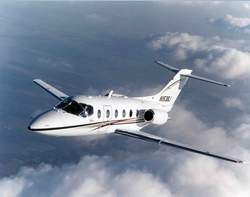Three Incidents In Past Two Years; Another In 2000
 Three Beechjet 400 aircraft have
experienced dual engine flameouts in the past three years... a
number that is more than a little disconcerting. After
investigations into all three incidents, the National
Transportation Safety Board Friday issued recommendations to the
Federal Aviation Administration aimed at preventing those
flameouts. One of the recommendations is classified as
"Urgent."
Three Beechjet 400 aircraft have
experienced dual engine flameouts in the past three years... a
number that is more than a little disconcerting. After
investigations into all three incidents, the National
Transportation Safety Board Friday issued recommendations to the
Federal Aviation Administration aimed at preventing those
flameouts. One of the recommendations is classified as
"Urgent."
The planes were equipped with Pratt & Whitney Canada
(P&WC) JT15D-5 engines. In all three cases, the aircraft
landed safely and without injury.
Two of the flightcrews were able to restart at least one engine;
the third landed without any engine power. All the airplanes were
operating at between 38,000 and 40,000 feet near convective
activity when the flameouts occurred, and they all occurred after a
power reduction.
The flameouts occurred July 12, 2004 near Sarasota, FL; November
28, 2005 near Jacksonville, FL; and on June 14, 2006 near Norfolk,
Virginia. In addition, a similar case has come to light that
occurred April 23, 2000 in Brazil.
Mark V. Rosenker, Chairman of the NTSB, said that "dual-engine
flameout is an unacceptable risk that needs to be addressed as
quickly as possible."
According to the FAA's specialist on engine icing, convective
storms can pump significant amounts of moisture into the upper
atmosphere, and the blowoff from the tops of these storms can
contain significant amounts of ice crystals.
A P&WC study concluded that with engine anti-ice turned off,
it was possible for ice crystals to build up on the leading edges
of the JT15D-5 engine's front inner compressor stator and that the
buildup could lead to a compressor surge and/or flameout.
The Safety Board's urgent recommendation said that the FAA
should require Beechjet 400 pilots to activate ignition and
anti-ice systems at high altitude whenever they are in or near
visible moisture, or near convective storm activity, or before any
power reduction while in those conditions. The Safety Board
believes that many pilots may not be aware of the risk posed by ice
crystals at high altitudes.
In addition to the urgent recommendation, the Board also issued
three other recommendations dealing with the kind of information
provided to pilots and with research to develop an ice detector
that would alert pilots to internal engine icing.
 Recommendations
Recommendations
- Immediately require Beechjet 400 pilots to activate the engine
ignition and anti-ice systems at high altitude whenever they are in
or near visible moisture, or near convective storm activity, or
before any power reduction unless the pilots can verify that the
airplane is not in or near visible moisture or near convective
storm activity. (A-06-56) Urgent
- Require Raytheon to incorporate the information regarding
anti-ice operation and ice formation contained in Safety
Communiqué' No. 269 into the Beechjet 400 airplane flight
manual. (A-06-57)
- Incorporate the information regarding anti-ice operation and
ice formation contained in Raytheon's Safety Communiqué' No.
269 into the airplane flight manuals of other JT15D-powered
airplanes. (A-06-58)
- Work with engine and airplane manufacturers and other industry
personnel as well as the appropriate international airworthiness
authorities to actively pursue research to develop an ice detector
that would alert pilots to internal engine icing and require that
it be installed on new production turbojet engines, as well as
retrofitted to existing turbojet engines. (A-06-59)
 Classic Aero-TV: Remembering Bob Hoover
Classic Aero-TV: Remembering Bob Hoover ANN FAQ: Follow Us On Instagram!
ANN FAQ: Follow Us On Instagram! ANN's Daily Aero-Linx (05.15.24)
ANN's Daily Aero-Linx (05.15.24) ANN's Daily Aero-Term (05.15.24):Altimeter Setting
ANN's Daily Aero-Term (05.15.24):Altimeter Setting Aero-News: Quote of the Day (05.16.24)
Aero-News: Quote of the Day (05.16.24)




